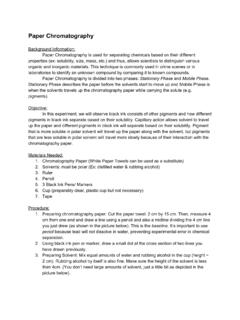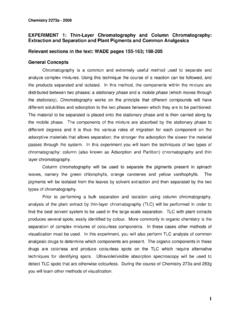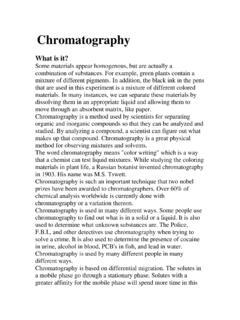Transcription of Paper Chromatography of Pigments in a Spinach Leaf
1 Paper Chromatography of Pigments in a Spinach Leaf INTRODUCTION Colored molecules or Pigments often occur as mixtures in nature. An example is the Spinach leaf, which appears dark green, but is actually a mixture of several Pigments of different color. In order to identify the individual Pigments , chemists use a technique known as Chromatography ( chroma refers to color) to separate out the different Pigments . Here we will use the simplest of Chromatography techniques called Paper Chromatography . Chromatography is an analytical method permitting the separation of a mixture into its molecular components. In this technique, a concentrated spot of the pigment mixture is deposited at one end of a Paper strip. The Paper strip is called the stationary phase. The end of the Paper strip containing the pigment mixture spot is then placed in a beaker containing a small amount of solvent, which is called the mobile phase.
2 Care is taken to NOT have the pigment spot immersed in the solvent. The solvent will then move up the Paper strip by capillary action, dissolving the pigment spot when it is reached, and separating out the different Pigments as the solvent moves up the Paper . The different Pigments are then deposited along the length of the Paper strip according to their solubility in the solvent. The polarity of the mobile phase affects the distance that each pigment travels on the Paper strip. If the mobile phase is very polar, then polar Pigments will travel the farthest. If the mobile phase is nonpolar, then nonpolar Pigments move further up the Paper . This is because Like dissolves like, that is, Pigments with a chemical composition similar to the composition of the solvent will dissolve better in that solvent and therefore, move further up the Paper .
3 An example of a polar solvent is water while ethanol is more nonpolar. The greater the attraction between the molecules and the stationary phase, the slower the molecules move on the plate. The greater the solubility of the components in the mobile phase, the greater the distance the molecules move. For a given mobile phase, Rf, the ratio of the distance traveled by the pigment to the distance traveled by the solvent, is an identifying characteristic of that pigment. = ( ) In this experiment, the Pigments you will identify are as follows: A) Chlorophyll a: bright green, blue-green (left); Chlorophyll b: yellow green (right; differs from above by one functional group) B) Carotene: light yellow orange C) Xanthophyll: yellow to gray D) (Basic structure of) Anthocyanin: red EXPERIMENTAL PROCEDURE Materials needed: Chromatography Paper (stationary phase) Chromatography chamber ( A 400 mL or larger beaker with Aluminum foil as cover) Ruler Pencil (do not use pen) Mortar and pestle Acetone Chromatography solvent mixture Petroleum ether: Acetone 9:1 (mobile phase) ~ 10 Spinach leafs Sand Magnesium sulfate anhydrous 1) Place in a mortar about 10 leave of fresh Spinach , and combine them with 6 grams of sand and 2 grams of anhydrous magnesium sulfate.
4 Add 2 mL of acetone. Using a pestle grind the mixture until a green solution is formed and most of the Spinach has turned into a pulp. The anhydrous magnesium sulfate will remove the water from the leaves. 2) Allow the mixture to stand for 10 minutes. 3) Obtain a Chromatography chamber (a beaker covered with a watch glass or aluminum foil) and add developing solvent (a mixture of petroleum ether and acetone). The solvent should completely cover the bottom of the chamber to a depth of approximately cm. 4) Obtain Chromatography Paper . Make sure that it fits into your beaker. Cut the top short edge of the Paper strip if you need to adjust the length, or take a larger beaker. 5) Use a pencil (why not an ink pen?) to draw a line 1 cm above the base of the Paper as shown below. This is the "START" line for your chromatograph where you will deposit your Spinach Pigments .
5 Mark a dot on the line, labeled with the letter e (leaf extract) 6) Fill a capillary tube by placing it in the leaf extract (it will fill by capillary action). Keep your finger off the end of the capillary tube. Apply the extract to the center of the dot (e) on the Paper by quickly touching the end of the TLC applicator to the plate. Allow to dry (you can gently blow on the strip). Repeat several times to make a concentrated dot of extract. Be sure to let dry between applications. Try to make the spot as small as possible but dark enough to see the color clearly. 7) Very carefully, insert the Paper into the chamber so that the bottom of the Paper is immersed in the solvent. The START line should NOT be immersed into the solvent! Cover the chamber immediately! 8) Allow the Paper to develop and the Pigments to separate for approximately 10 minutes or until the solvent has reached about 1 cm from the top of the Paper .
6 As the solvent moves up the Paper you should see the different colored Pigments separating. Do not open the chamber or disturb it in any way 9) Remove the Paper from the chamber when the solvent front is approximately cm from the top of the Paper . With a pencil, mark the level of the solvent front (highest level the solvent moves up the Paper ) as soon as you remove the Paper from the chamber (the solvent evaporates and disappears quickly) This is your SOLVENT FRONT. Also outline each spot of separated Pigments on the chromatograph, quickly as some Pigments (especially the beta-carotene) may fade over time. Note the color of each spot. Identify the chromophore corresponding to each pigment spot using the colors above. 10) Record the results of the separation on the data sheet. 11) Discard the left over solvent mixture from your chamber to the waste bottle provided under the lab main fume hood!
7 Data Sheet Name_____ Date_____ Lab Section____ Be sure to answer all questions using complete sentences where appropriate. Distance traveled by the solvent _____ mm = ( ) Assign a band number for each pigment band - you should see greens, yellows, oranges, etc. Band Color Plant Pigment Distance (mm) (from original dot to center of separated pigment band) Rf (use formula) Yellow to Yellow-orange Carotene Yellow Xanthophyll Bright Green to Blue Green Chlorophyll a Yellow Green to Olive Green Chlorophyll b QUESTIONS 1. How many spots ( Pigments ) did you identify? 2. Which of your pigment molecules was the most nonpolar? Polar? 3. Why should you not use ink on the coating to mark your pigment placement? 4. What other pigment mixtures might this technique be used for (HINT: black is a mixture of many colors)?
8 5. The leaves of maple trees are green in the summer, but turn orange or red in the fall. Considering your results from the Spinach leaf Chromatography , why do you not see the orange and red maple leaf Pigments in the summer? Why are they visible in the fall?







